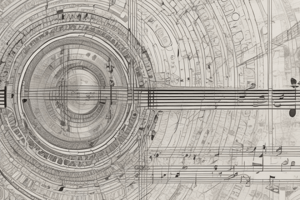Podcast
Questions and Answers
What is the primary tone an instrument produces, often referred to as its 'pitch'?
What is the primary tone an instrument produces, often referred to as its 'pitch'?
- Harmonics
- Fundamental frequency (correct)
- Vibrato
- Envelope
Which of the following refers to the secondary tones that are integer multiples of the fundamental frequency?
Which of the following refers to the secondary tones that are integer multiples of the fundamental frequency?
- Harmonics (correct)
- Spectral balance
- Envelope
- Noise
What are the initial and terminating stages of a sound called, respectively?
What are the initial and terminating stages of a sound called, respectively?
- Attack and decay (correct)
- Harmonics and pitch
- Spectral balance and envelope
- Vibrato and noise
Which aspect of sound quality relates to the relative amplitudes of harmonics and their distribution across the frequency spectrum?
Which aspect of sound quality relates to the relative amplitudes of harmonics and their distribution across the frequency spectrum?
What unpredictable fluctuations add a unique coloration to the sound?
What unpredictable fluctuations add a unique coloration to the sound?
Which term refers to a slight fluctuation in pitch that can alter the timbre of a sound?
Which term refers to a slight fluctuation in pitch that can alter the timbre of a sound?
What contributes to the timbral qualities of musical instruments?
What contributes to the timbral qualities of musical instruments?
How can pressing harder on a violin string affect its tone?
How can pressing harder on a violin string affect its tone?
Which factor does NOT affect the timbral qualities of musical instruments?
Which factor does NOT affect the timbral qualities of musical instruments?
What does timbral balance refer to?
What does timbral balance refer to?
How do vibration behavior and incoming sound waves impact timbre?
How do vibration behavior and incoming sound waves impact timbre?
What can enhance our appreciation and enjoyment of music, according to the text?
What can enhance our appreciation and enjoyment of music, according to the text?
Flashcards are hidden until you start studying
Study Notes
Exploring Timbre: Sound Quality, Instrumentation, and Tone Color
Timbre, often referred to as tone color, is a crucial aspect of sound that distinguishes one instrument or voice from another, even when they produce the same pitch and rhythm. This quality extends beyond music into our everyday experiences with sound, shaping the way we perceive and interpret the world around us.
Sound Quality
Sound quality, in the context of timbre, refers to the unique combination of characteristics that define the tonal character of an instrument or voice. These attributes include:
-
Fundamental frequency: The primary tone an instrument produces, often referred to as its "pitch."
-
Harmonics: Secondary tones that areinteger multiples of the fundamental frequency.
-
Attack and decay: These are the initial and terminating stages of a sound, respectively.
-
Spectral balance: The relative amplitudes of the harmonics and their distribution across the frequency spectrum.
-
Envelope: The overall shape of the sound waveform, which includes attack, sustain, and decay.
-
Noise: Unpredictable and random fluctuations that add a unique coloration to the sound.
-
Vibrato: A slight fluctuation in pitch, which can alter the timbre of a sound.
These aspects of sound quality, when combined in various ways, create the unique timbre we hear when listening to instruments like the piano, violin, or trumpet.
Instrumentation
Each instrument has its own unique timbre. For example, the violin produces a bright, warm, and relatively thin sound with a rich harmonic spectrum, while the trumpet has a brassy, metallic timbre with a bright and penetrating tone. These differences are due to inherent characteristics such as:
-
Physical construction: An instrument's materials and design (e.g., wood or metal body, string or reed) contribute to its timbral qualities.
-
Vibration behavior: The way an instrument's materials interact with incoming sound waves affects the timbre.
-
Amplification: Some instruments, like the piano and guitar, amplify sound via strings or the body, affecting timbre.
-
Bowing or blowing techniques: The way an instrument is played can influence its timbre. For instance, pressing harder on a violin string can create a darker tone.
-
Technique and skill: The way a musician plays an instrument can also affect its timbre. Higher skill levels often result in more nuanced and expressive sound qualities.
Tone Color
Tone color, or timbre, is the subjective perception of the unique sound quality produced by instruments and voices. Although it is inherently subjective, there are certain aspects of tone color that can be described objectively:
-
Timbral spectra: The frequency distribution of harmonics in a sound wave.
-
Timbral texture: The way harmonics are related to each other in amplitude, phase, and frequency.
-
Timbral balance: The relative intensities of different frequency components in a sound wave.
-
Timbral complexity: The number of frequency components present in a sound wave.
-
Timbral change: The way tone color changes over time as a result of factors such as vibrato, attack, and decay.
Tone color is a critical component of music, affecting our emotional response and level of engagement with the art form. For example, a rich and warm timbre might evoke feelings of relaxation, while a bright and penetrating tone could convey excitement or urgency.
In conclusion, understanding timbre, its subtopics of sound quality, instrumentation, and tone color, can greatly enhance our appreciation and enjoyment of music. By exploring the unique qualities of instruments and voices, we can better understand the intricate world of sound and its profound effects on our perception and experience of the world around us.
Studying That Suits You
Use AI to generate personalized quizzes and flashcards to suit your learning preferences.




